[ Chapter 1 ] [ Chapter 2 ] [ Chapter 3 ] [ Chapter 4 ] [ Chapter 5 ] [ Chapter 6 ] [ Chapter 7 ] [ Index ]
Chapter 5 - Location Management
Introduction Applications
- Tied to wireless hardware (mobile users)
- Mobile software, i.e., code or data (migration, mobile agents, ubiquitous computing)
Taxonomy
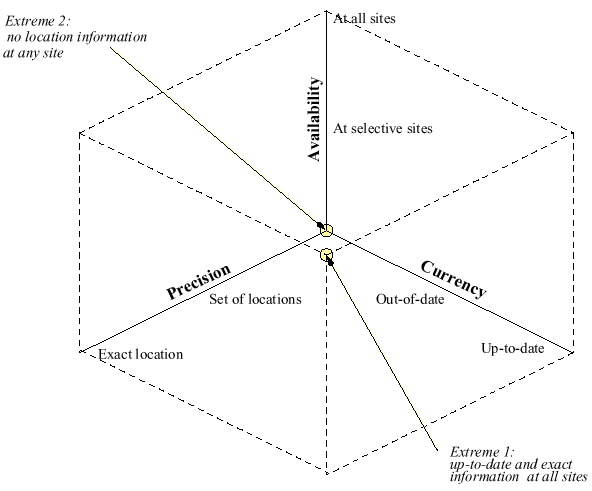
Infrastructure
- Cellular Architecture - WAN - LAN
- GPS
Architectures
Home Location Register (HLR) Visitor Location Registers (VLR)
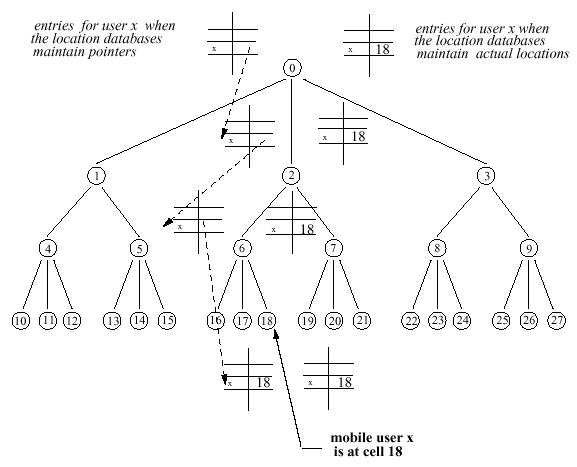
Comparison
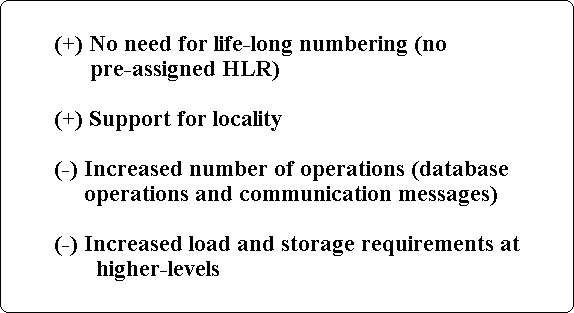
Placement of Databases
Entries at the Leaves (VLRs)
Flat, expanding, hybrid
Optimization
Objective functions: (a) the number of database updates and accesses, (b) the
communication cost, (c) the sum of the traffic on the network link or links. Constraints: (a) database capacity (b) link capacity, and (c) storage.
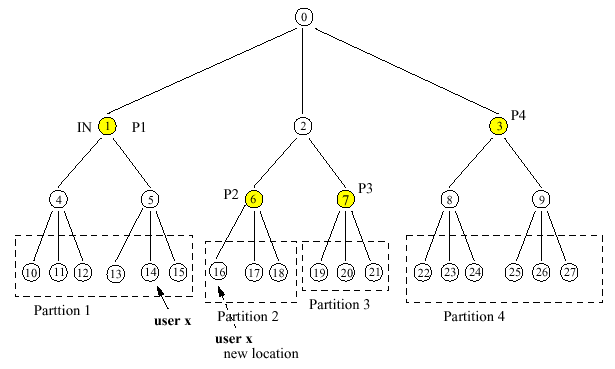
Two-Tier
After a call, save location at the caller's VLR
Invalidation
Eager caching Lazy caching
Performance
A hit ratio threshold pT = CH=CB, where CH is the cost of a lookup when there is a hit and CB the cost of the lookup in the non-caching scheme.
Among other factors, CH and CB depend on the relative cost of querying HLR's and VLR's. In practice, it is expected that LCMRT > 7
Other
Replacement? Initialization?
Hierarchical
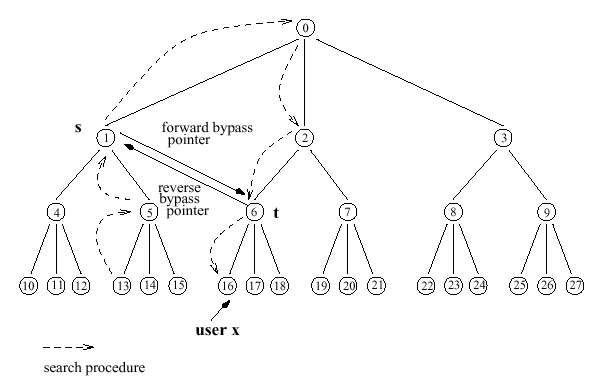
Variations
- Simple caching - level caching
- Lazy
- Exact locations - pointers
Performance
Regional Call-to-Mobility Ratio (RCMR) for users with RCMR > 5, a 30% reduction when considering only the number of database operations. More on granularity: caching and partitions
Replicate the location of specific users at selected sites. Judicious replication of i at j
á * Ci,j >= â * Ui (1)
á : cost savings when a local lookup, as opposed to a remote query, succeeds
â: replica update cost Ci, j: expected number of calls from j to i over time T, and Ui: number of moves made by i over T.
Other Factors:
Database service capacity, storage
Other Issues:
- Where to keep replication set
- Other applications
- Granularity of location replicas
Comparison with
file allocation [3]and database allocation [12] problem.Replication
1. Per User Profile Replication [17]
Problem Formulation
Let M: the number of users and N: number of zones. Find a replication assignment
of a user's profile Pi to a set of zones R(Pi) such that the system cost is minimized:

Given constraints on the maximum number pj of replicas per zone Zj and on the maximum number of replicas ri per user Pi.
Solution: Construct a flow network F Vertices: Edges:
A pair (c, p) of attributes with each edge s ---> Pi, with (c, p) = (0, ri) Zj ---> t with (0, pj ) Pi
---> Zj with (c, p) = (
Compute a minimum-cost maximum- flow on F
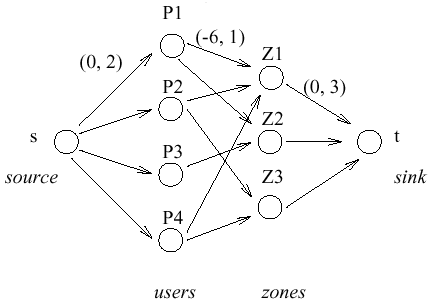
Extensions
Adaptation to changing calling and mobility patterns Compute F
2. Working Set Replication [14]
Assumption: each user communicates frequently with a small number of sources, called its working set, maintain copies of its location at the members of this set. Similar to
the per-user replication but no constraints, thus the decision whether to replicate Pi at Zj made independently at each unit Pi Evaluate Inequality (??) locally at the mobile unit P
i when:
- a call is set up and the caller's site is not a member of the working set of the callee
- Pi moves.
If (1) holds, the caller enters the set
Re-evaluate (1) for all members of the working set Drop a member, if (1) does not hold
3. Replication in Hierarchical Architectures
Note: databases at higher levels tend to be selected as replication sites over databases at lower levels,
HiPer[7]
- It is shown that: it is never judicious to replicate i at j if LCMRi,j < Rmin, while it is always judicious to replicate, if LCMRi,j < Rmax.
- Constraints: Nmax: maximum number Nmax of replicas per user and a cap L on the maximum level at which locations may be replicated.
- Off line algorithm that proceeds in two phases:
1.In a bottom-up traversal, allocate replicas of i at all databases with LCMRi,j >= Rmax as long as the number of allocated replicas n does not exceed Nmax.
2.If n <= Nmax, in a top-down traversal, allocate the remaining replicas to databases below level L with the largest non negative LCMRi,j - Rmax
4. The Adaptive Data Replication (ADR) Algorithm [21]
Presents a solution to the general problem of determining an optimal (in terms of communication cost) set of replication sites for an object in a distributed system, when the object's read-write pattern changes dynamically.
Preliminaries
- Tree-structure architectures
- R: the current replication set of object x
- A site i is an R-neighbor, if it belongs to R but has a neighbor site that does not belong to R.
- When site R is not a singleton set, a site i is an R-fringe site, if it is a leaf at a subgraph induced by R.
The Algorithm
- R is updated periodically every T, specifically every T three tests are performed:
- The expansion test performed by each R-neighbor site i Site i invites each of its neighbor j not in R to join R, if the number of reads that i received from j during the last T is greater the number of writes that i received during T from i itself or from a neighbor other than j.
The ADR Algorithm (continue)
- The contraction test executed by each R-fringe site i. Site i requests permission from its neighbor site j in R to exit R, if the number of writes that i received from j during T period is greater than the number of reads that i received during T.
- If site i is both an R-neighbor and an R - fridge, it executes the expansion test first, and if the test fails (i.e., no site joins R), then it executes the contraction test.
- The switch test is executed, when R is a singleton test and the expansion test that the single site i in R has executed fails.
Site i asks a neighbor site n to be the new singleton site, if the number of requests received by i from n during T is larger than the number of all other requests received by i during T
The ADR algorithm is shown to be convergent-optimal: starting at any replication scheme, it converges to the replication scheme that is optimal to
the current read-write pattern. The convergence occurs within a number of time periods that is bounded by the diameter of the network.
When the number of moves that a user makes is large relative to the number of calls it receives, defer updating database entries holding the user's location.
Two-tier Architectures [5]
x's HLR is not updated, each time x moves to a new location.
Leave a forwarding pointer at the VLR at x's previous location to point to the VLR at the new location.
Calls follow a chain of forwarding pointers. The length of the chain of
forwarding pointers grows up to a maximum value of K. Since the approach is applied on a per-user basis, the increase in the cost of call operations affects only the specific user. The router optimization
extensions to IEFT Mobile IP protocol include pointer forwarding in conjunction with lazy caching Performance depends on the cost of setting up and traversing pointers relative to the costs of updating the HLR. An analytical estimation
Hierarchical Architectures
When x moves from i to j, instead of updating all databases on the path from j through LCA(j, i) to i, only the databases up to a level m are updated. A forwarding
pointer is set from node s to node t, where s is the ancestor of i at level m, and t is the ancestor of j at level m.
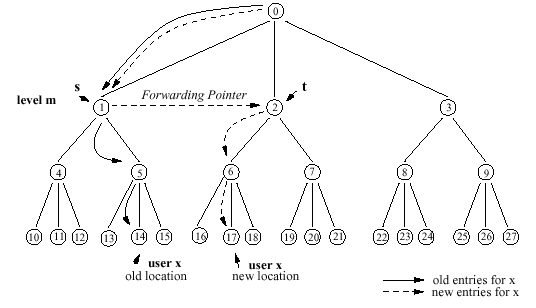
Simple forwarding vs. level forwarding When entries at the internal nodes are actual addresses
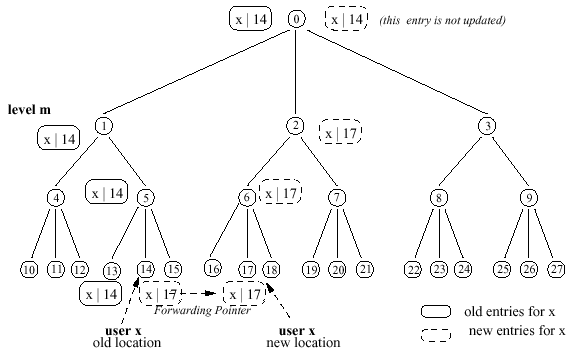
An analysis of a forwarding method when entries are actual addresses [10]
along with caching based on the degree of mobility (CMR) host (low or high) and on whether it has a large number of frequent callers. Updating obsolete entries in databases at levels higher than m: e.g.,
after a successful lookup, or each node sends a location update message to all location servers on the path to the root during off-peak hours. Pointer reduction
Applications in Software Systems to maintain references to mobile objects:
Emerald [9] is an object-based system in which objects move within the system.
SSP chains [16] are chains of forwarding pointers for transparently migrating object references between processes. SSP uses a short-cutting technique.
Taxonomy
Exploit knowledge about the calling and moving behavior of mobile objects:
stability and locality. Stability of calls: most calls for a user originate from the same set of locations. Stability of moves: users tend to move inside specific regions. Locality: the
cost of a lookup or update operation increases with the distance. Local operations (moves to neighbor locations or calls from near-by places) are common and should cost less than remote operations. Relative frequency
of calls and moves, since often decrease the cost of either the move or call operation in the expense of the other.
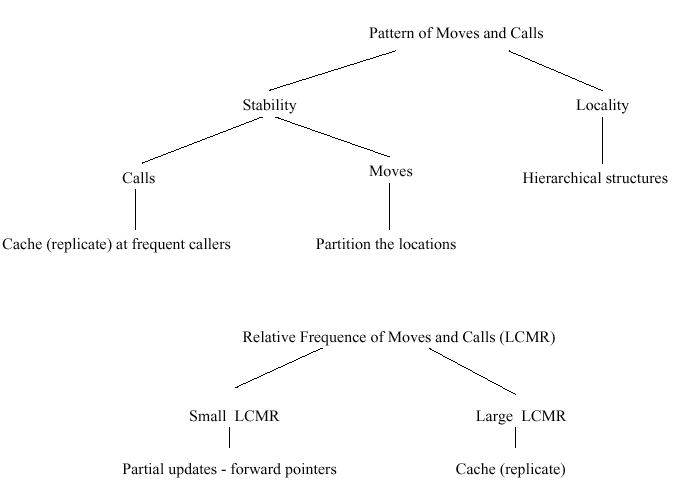
More specific types of movement and calling: e.g., follow a certain mobility pattern or there is an epicenter (e.g., home location) of movement. Models of movement can be used in guiding the search for the current location of a mobile object (see for example, Dynamic adaptation to the current pattern and ratio.
Employment on a per user basis - overall - per group of users (e.g., based on their geographical location or on their mobility and calling characteristics) all users that receive a large
number of calls) or a combination of both.
----------> Dynamic (adaptive) or static Variations
----------> Per object, group of objects, geographical region The topology of network
sites, how they are populated and their geographical connectivity. Scales with the number of mobile objects, operations and geographical distribution. Estimation of the current value of the CMR
- The running average algorithm [6]:
Maintain for every user the running counts of the number of incoming calls and the number of times that the user changes location.
- Store information about the CMR, for instance in the HLR, and download it during off-peak hours.
- Analytical estimations
For instance, if the coming call stream to a user is consider a Poisson process with arrival rate ë and the time a user resides in a region has a general distribution
with mean 1/ì, then LCMR
- Traces of actual moving users (for example, (SUMATRA) [19].
Evaluation based on database operations: Minimizing (a) the total number of database updates and queries, (b) the database load and size, and (c) the
latency of each database operation.
And communication: Reduce among others (a) the total number of messages, (b) the
number of hops, (c) the distance traveled, (d) the number of bytes generated, and (e) the sum of the traffic on each link or over all links.
Two-Tier Schemes
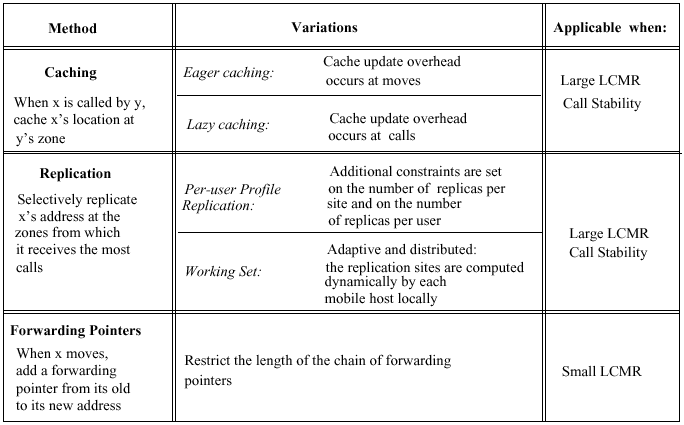
Hierarchical Schemes
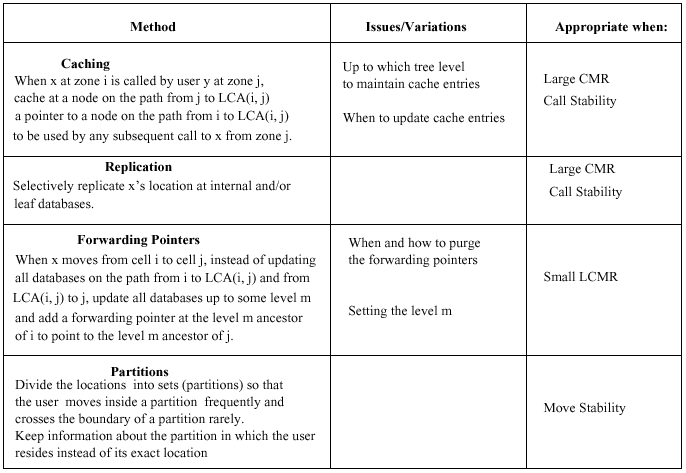
Moves and calls are issued asynchronously and concurrently and each results in number of database operations => concurrency control to ensure correctness. Leave a forwarding pointer to the new location
- When a call reads obsolete data and fails, it is reissued. No upper bound on the number of attempts.
- Traditional database concurrency control techniques such as locking or timestamps.
- Impose a specific order on the execution of the operations
- First, add entries at the path from j to LCA(i; j) in a bottom-up fashion
- Then, delete the entries at the path from the LCA(i; j) to i in a top-down fashion.
- Special care so that during the delete phase, an entry at a level k - 1 is deleted only after servicing all lookups from higher-level databases.
- [2]: application to the regional matching method
When replication => coherency control protocols to maintain the replicas consistent
- An HLR or a master copy that is always consistent
- Use forwarding pointers to handle any incoming calls directed there from obsolete replicas.
Database recovery after the failure of a location database.
VLR Failure Restoration
Periodic Checkpointing
- If the VLR is checkpointed, the backup record is recovered.
- But if the backup is obsolete, then all areas within the VLR must be paged to identify the mobile users currently in the VLR's zone. Thus no improvement.
- GSM exercises periodic location updating: the mobile users periodically establish contact with the network to confirm their location.
- Periodic confirmation does not improve the restoration process, if the confirmation frequency < 0.1 times of the portable moving rate [11] .
Location Update on Demand [11]
- Eliminates the need for periodic confirmation messages.
- After a failure, a VLR restoration message is broadcasted to all mobile users in the area associated with the VLR.
- The mobile users then send a confirmation message. To avoid congesting the base station, each such message is sent within a random period from the receipt of the request.
HLR Failure Restoration
In GSM,
- The HLR database is periodically checkpointed. After an HLR failure, reloading the backup restores the database.
- If the backup is obsolete, calls are lost.
- Obsolete data are updated by either a call origination or a location confirmation
In IS-41,
- After an HLR failure, the HLR sends an \Unreliable Roamer Data Directive" to all associated VLRs.
- The VLRs remove all records of associated with that HLR.
- Later, when a portable is registered at a VLR, the VLR sends a registration message to the HLR allowing it to be incrementally reconstructed. Before, calls are lost.
Aggressive Restoration [11]
- HLR restores its data by requesting all the VLRs referenced in its backup copy to provide exact location information
- An algorithm to identify VLRs that are not mentioned in the backup; e.g., VLRs such that there are portables that moved in between the last HLR checkpointing and the failure and not out
Advanced queries that involve the location of moving objects Examples
- May not include location directly, but may require tracking mobile objects indirectly, e.g., queries that involve data produced and located at mobile hosts.
- May be imposed by either static or mobile users and may include databases located at both static and mobile sites.
- Have both a spatial dimension, e.g., involve the position of a user and a temporal dimension, e.g., involve time.
- May include transient data, which is data whose value changes while the queries are being processed, e.g., a moving user asking for nearby hospitals.
- Continuous queries, e.g., a moving car asking for hotels locating within a radius of 5 miles and requesting the answer to the query to be continuously updated. Issues related to continuous queries include when and how often should they be re-evaluated and the possibility of a partial or incremental evaluation.
- Imprecision
Bounded Ignorance
How to derive an optimal execution plan for locations query that will acquire only the missing information necessary to answer it [4].
Partitions The system guarantees bounded ignorance: in that the actual and stored location of a user is always in the same partition. To determine the actual location of
a user, searching in the partition of its stored location is sufficient. Deriving an optimal execution plan reduces to determining an optimal sequence in which to search inside the partitions of the users involved in
the query.
Continuous Queries
The position of a moving object is represented as a function of time. [18].
Thus, position changes continuously with time even without an explicit update through a database operation.
A new data model, called MOST, is proposed to incorporate such dynamic attributes.
MOST enables queries that refer to future
values of dynamic attributes, e.g., retrieve all the airplanes that will come within 30 miles in the next 10 minutes. The answer to future queries is tentative.
Routes [20]
Objects move on predefined routes.
The current position of an object is modeled as the distance from its starting point along a given route.
Indexing the location of moving objects.
[1] I. F. Akyildiz and J. S. M. Ho. Dynamic Mobile User Location Update for Wireless PCS Networks. ACM/Baltzer Wireless Networks Journal, 1(2), 1995. [2] B. Awerbuch and D. Peleg. Concurrent Online Tracking of Mobile Users. In Proceedings of SIGCOMM 91, pages 221{233, November 1991. [3] L. W. Dowdy and D. V. Foster. Comparative Models of the File
Assignment Problem. ACM Computing Surveys, 14(2):288{313, June 1982. [4] T. Imielinski and B. R. Badrinath. Querying in Highly Mobile Distributed Environmnets. In Proceedings of the 18th International Conference onVery
Large Data Bases (VLDB 92), 1992. [5] R. Jain and Y-B. Ling. A Auxiliary User Location Strategy Employing Forwarding Pointers to Reduce Network Impacts of PCS. Wireless Networks, 1:197{210, 1995. [6] R. Jain, Y-B. Ling, C. Lo, and S. Mohan. A Caching Strategy to Reduce Network Impacts of PCS. IEEE Journal on Selected Areas in Communications, 12(8):1434-44, October 1994. [7] J. Jannink, D. Lam, N.
Shivakumar, J. Widom, and D.C. Cox. Efficient and Flexible Location Management Techniques for Wireless Communication Systems. ACM/Baltzer Journal of Mobile Networks and Applications, 3(5):361-374, 1997. [8] D. B.
Johnson and D. A. Maltz. Protocols for Adaptive Wireless and Mobile Networking. IEEE Personal Communications, 3(1), 1996. [9] E. Jul, H. Levy, N. Hutchinson, and A. Black. Fine-Grained Mobility in the Emerald System.
ACM Transactions on Computer Systems, 8(1):109{133, February 1988. [10] P. Krishna, N.H. Vaidya, and D. K. Pradhan. Static and Dynamic Location Management in Mobile Wireless Networks. Journal of
Computer Communications (special issue on Mobile Computing), 19(4), March 1996. [11] Y-B. Ling. Failure Restoration of Mobility Databases for Personal Communication Networks. Wireless Networks, 1:367-372, 1995. [12] M. T. Ozsu and P. Valduriez. Principles of Distributed Database Systems. Prentice Hall, 1991. [13] E. Pitoura and I. Fudos. An E_cient Hierarchical Scheme for Locating Highly Mobile Users. In
Proceedings of the 7th Iternational Conference on Information and Knoweledge Management (CIKM'98), November 1998. To appear. [14] S. Rajagopalan and B. R. Badrinath. An Adaptive Location Management Strategy for Mobile
IP. In Proceedings of the 1st ACM International Conference on Mobile Cmputing and Networking (Mobicom'95), Berkeley, CA, October 1995. [15] C. Rose and R. Yates. Location Uncertainty in Mobile
Networks: a Theoretical Framework. IEEE Communications Magazine, 35(2), 1997. [16] M. Shapiro, P. Dickman, and D. Plainfosse. SSP Chains: Robust, Distributed References Supporting Acyclic Garbage Collection. Technical
Report Technical Report 1799, INRIA, Rocquentcourt, France, November 1992. [17] N. Shivakumar and J. Widom. User Profile Replication for Faster Location Lookup in Mobile Environments. In Proceedings of the 1st ACM
International Conference on Mobile Computing and Networking (Mobicom'95), 161-169, October 1995. [18] A. P. Sistla, O. Wolfson, S. Chamberlain, and S. Dao. Modeling and Querying Moving Objects. In Proceedings of the
13th International Conference on Data Engineering (ICDE 97), 1997. [19] Stanford Pleiades Research Group. Stanford University Mobile Activity TRAces (SUMATRA). www-db.stanford.edu/sumatra. [20]
O. Wolfson, S. Chamberlain, S. Dao, L. Jiang, and G. Mendez. Cost and Imprecision in Modeling the Position of Moving Objects. In Proceedings of the 14th International Conference on Data Engineering (ICDE 98), 1998.
[21] O. Wolfson, S. Jajodia, and Y. Huang. An Adaptive Data Replication Algorithm. ACM Transactions on Database Systems, 22(2):255{314, June 1997.
[ Chapter 1 ] [ Chapter 2 ] [ Chapter 3 ] [ Chapter 4 ] [ Chapter 5 ] [ Chapter 6 ] [ Chapter 7 ] [ Index ]
[EPL651] [Course Contact] [Schedule & Readings] [Assignments] [Resources] [What's New]